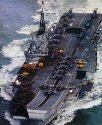I checked and this is what I found
Air group at the height of the Falklands Conflict:
- - 16 Sea Harrier FRS.1
- - 5 Sea King HAS.5
- - 5 Sea King HC.4
- - 10 Harrier GR.3
That had to be a tight squeeze!
The Numbers varied throughout the conflict, and it was a little more complicated:
When she sailed for the South Atlantic Hermes had on board the five Sea harriers of 800NAS plus seven more from 899NAS (three more 899 aircraft were similarly assigned to Invincible's 801NAS); once at sea all the SHARs were absorbed into 800 for the duration. Later in the conflict four more SHARs from 809NAS were flown on board as attrition replacements and also absorbed into 800 (again the other four from 809 went to Invincible). In photos 809's aircraft can be distinguished by virtue of being painted in a lighter grey low viz scheme than all the SHARs that had sailed with the Task Force earlier. The overall dark Grey was adopted postwar for the rest of the FRS1's career; when the fleet was converted to FA2 standard the light grey scheme was adopted.
Also when Hermes sailed she did indeed have 826NAS which was her resident ASW helicopter sqn. They had a normal complement of nine Sea King HAS2s, as far as I can tell all nine sailed with her. Additionally 846NAS embarked for the journey south, the first commando sqn equipped with the then new Sea King HC4 (sister sqn 845NAS was still equipped with Wessex HU5s). Exactly how many HC4s they had is again difficult to be sure of but again normal complement at the time was at least eight helos. These choppers spent most of their time prior to the landings ferrying troops and equipment between ships of the Task Force,Primarily the LPDs and LSLs which had no hangars of their own, and after the landings spent most of their time ashore, so were in effect only 'hitching a lift' with Hermes. Once they had gone ashore space was freed up aboard Hermes and was immediately snapped up by the Harrier GR3s of 1(F) sqn RAF, which had been modified with tie down points like the Sea Harriers for deck parking, and were also wired up to fire Sidewinders to act as attrition replacements for the Sea Harriers (in the event they were not needed to do this and spent the war on ground attack missions). Eight aircraft were operated from Hermes during the conflict. At the end of the War these aircraft moved ashore to Port Stanley Airport (RAF Stanley for the next few years).
Hermes also operated at least one and possibly two Lynx HAS2s during the war, one aircraft made homeless after HMS Sheffield was hit, and the aircraft were used for general utility and ECM purposes.
At the end of the War, Invincible was first given a couple of weeks 'off' to perform self maintenance, after which there was some swapping of aircraft and personnel between the two carriers so that all of 809 could return home with Hermes and Invincible could remain on station. Below are two pictures showing her air group as it looked when she returned to Portsmouth in July 82. Only six SHARs are on deck, effectively the remainder of 800NAS as 809 had already flown off to their base at RNAS Yeovilton for all of two days leave, before re embarking aboard the newly completed HMS Illustrious for the return trip to the South Atlantic, so the ship and aircraft could relieve HMS Invincible and she could return home. Lusty returned home in December after RAF Stanley had been repaired and the runway enlarged so that a sqn of Phantoms could take over the AD role. 809 disbanded on return to the UK.


As well as the SHARs and Sea Kings on board she also had a number of Wessexs and a couple of Lynx as mentioned earlier. The Sea King HC4s stayed behind to help with logistics in the Falklands as well as some of the Wessexs. So the actual composition varied often throughout the war, but it should be remembered Hermes was a bigger ship that the Invincibles and had more space, both in the hangar and on deck for parking aircraft. The Sea Harrier was a relatively small aircraft, and it is generally accepted Hermes could have operated up to thirty of them as her helicopter sqn. In the event she operated about twenty at most (12 SHARs and 8 GR3s) in the latter half of the campaign plus helos:



The capability that Hermes provided in 1982 is what the RN has been trying to regain with the CVFs, ships that can act simultaneously as CVs and LPHs and to do both jobs together requires a big hull... 70,000tonnes as it has turned out!













